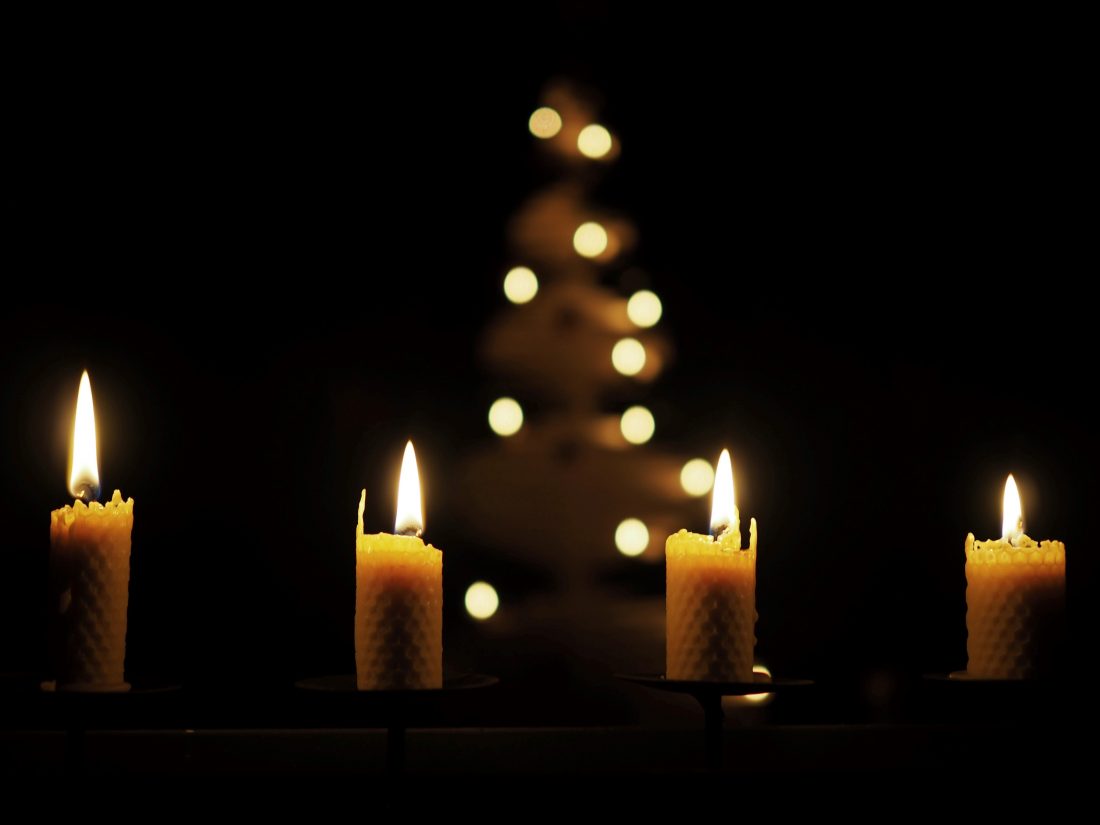Priscilla Hammond ~ Living a Life of Advent Light: When a Wreath Is More Than a Wreath

Many churches are currently setting up Advent wreaths to mark the weeks leading up to Christmas. The four candles that encircle the wreath illuminate the area around them as they point toward the center candle. Those outer candles relate to prophecy, Bethlehem, shepherds, and angels, while the center candle alludes to Christ.
The prophecy candle represents the expectation of the coming Messiah and the hope of salvation. The Bethlehem (manger) candle represents love, the shepherds represent joy, the angels represent peace, all pointing to the middle Christ candle, which represents purity.
We read the Scripture and light the candles each year. However, what if we see the Advent wreath as not just a representation of the Christmas season, but of our active faith? What if Advent is a time to remind us not just of the historical actors in the Christmas drama but also of our ongoing response to Christ?
The prophetic message of hope is needed today
Skepticism seems to be the modus operandi of our socially mediated culture. Disbelief, distrust, doubt, and despair fill our newsfeeds. These are the opposite of hope. During this season of Advent, what if we choose to display hope in our communications? What if we embody the prophetic promise of Isaiah 43:19, “See, I am doing a new thing! Now it springs up; do you not perceive it? I am making a way in the wilderness and streams in the wasteland” and looked for hope in the world? What if, instead of seeing a valley of dry bones, we have the prophetically hopeful eyes of Ezekiel? What if our ministry to our community focuses on being a ministry of hope?
Love is the gift we celebrate at Christmas
If you’ve attended a sporting event, you’ve probably seen John 3:16 on a placard in the stands. “For God so loved the world that he gave his one and only Son, that whoever believes in him shall not perish but have eternal life.” It’s a popular verse, but a fan-filled arena wasn’t the original context. This verse was the response of Jesus to Nicodemus, who saw God in Jesus (John 3:2). Jesus didn’t go around yelling at people about God outside of their context; He shone God’s love into their contexts. If I communicate hope, but do it without love, I’m just making noise (1 Cor. 13).
Love is what we have that causes someone to ask what we have and how we came to have it. We don’t need to bang a gong; we just need to let the light of Love shine. The prophetic word of the coming Christ is delivered through a man-made manger—that is the incarnation of love into our context. What if our celebration of Christmas focuses on loving our neighbors and our enemies (Matt. 5:43-48) wherever they are, not just asking them to join a bunch of Jesus fans in an arena?
I’ve got the joy, joy, joy, joy down in my heart (where!?)
Imagine the shepherds, biding their time in the fields, hanging with the sheep, doing what shepherds do, when suddenly, “An angel of the Lord appeared to them, and the glory of the Lord shone around them, and they were terrified” (Luke 2:9). Joy does not seem like the right word for that moment. The shepherds might have sung “I’ve got the fear, fear, fear, fear, down in my gut.” But they were told the good news that joy was on the way—a joy that came from the hope that love was awaiting them. This prevenient grace of God went out and let people know that hope, love, and joy was there for them. They didn’t hear about it in church; they received word while they were working and hanging out. When Jesus gave the disciples (us) our commission, he said, “Go and make disciples” (Matt. 28:19a). That word, go, means to pursue the journey you’ve already started. On the first Christmas, the truth was shone into the place where the people were working and hanging out. What if we choose joy and spread the prevenient grace of God while we are on our journeys in our communities, workplaces, and relationships?
Not that kind of peace
When Jesus was born, the angels declared, “Glory to God in the highest heaven, and on earth peace to those on whom his favor rests” (Luke 2:14); however, during his ministry Jesus said, “Do not think that I came to bring peace on the earth” (Matt. 10:34a). It’s the same word in both places, so did he change his mind? Or do we expect the wrong kind of peace? At the end of his life, he said, “Peace I leave with you; my peace I give you. I do not give to you as the world gives” (John 14:27a). We will always live in the midst of chaos, but we can receive peace, and we can give peace to others. Peace with God is received when we engage in the hope, love, and joy of the Christmas event. We will enjoy peace in our hearts, out of which peace with others can be possible. What if we can pass the peace of Christ in the chaos of our world?
Constructive interference
The Advent wreath uses light to symbolize the Christmas event. Jesus is the “light of the world” (John 8:12), and when we believe in him, we become “children of the light” (John 12:36). When light waves meet, constructive interference occurs and the two waves reinforce one another. These wavelengths combine to produce a super light wave.
As we embrace hope, love, joy, and peace, we reinforce the message of Christmas, and his light is multiplied into the world. What if Christians unite as the church, illuminating the world around us as we point toward the Christ?